You'll keep your air-dried fish fresh longer by focusing on three critical factors: moisture control, environmental conditions, and proper packaging. Start by ensuring thorough drying to achieve a water activity level below 0.85, which prevents bacterial growth. Store your dried fish at temperatures between 10-15°C with relative humidity below 75%, and use airtight containers or vacuum-sealed bags for storage. Regular inspections help catch any potential spoilage early, while consistent temperature and humidity monitoring maintains quality. Implementing proper handling techniques and understanding the science behind preservation can extend your dried fish's shelf life from weeks to months.
The Science Behind Air Drying
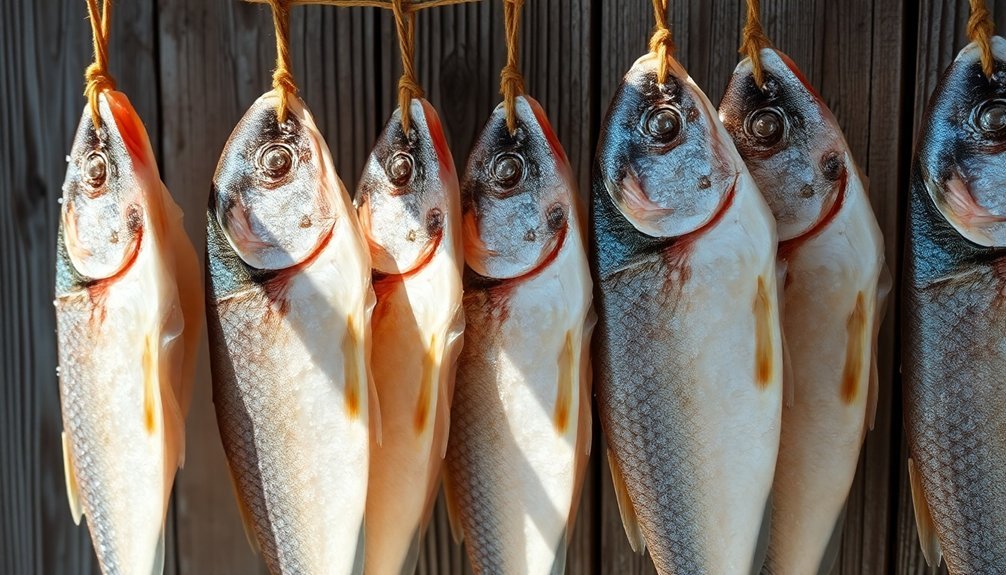
Anyone can understand the basic scientific principle behind air-dried fish: remove the water, and you'll stop bacteria from growing. When you expose fish to sun and wind, the moisture gradually evaporates from its tissues, creating an environment where microorganisms can't survive. This process relies on the scientific concept of water activity (aw), which measures how much water is available for microbial growth.
You'll find that temperature and humidity play essential roles in the drying process. Higher temperatures and lower humidity levels speed up moisture removal, making the process more efficient. Salt and spices are often added during drying to enhance flavor while helping reduce moisture content. As the water content decreases, you'll notice significant changes in the fish's physical structure. The proteins and fats undergo alterations, resulting in a more stable product that's less susceptible to spoilage.
When you're air-drying fish, you're actually triggering several chemical changes. The process modifies the fish's composition, affecting everything from its protein content to its texture and color.
Essential Moisture Control Methods
Understanding moisture control takes you beyond the basic science of air drying into practical methods that guarantee success. You'll need to focus on three critical aspects: air circulation, water activity monitoring, and proper storage conditions.
To effectively remove moisture, you'll want to ascertain constant airflow across your fish. Fan-driven systems work best for mechanical drying, while natural drying requires strategic placement to catch wind currents. You must maintain water activity (Aw) below 0.85 to prevent bacterial growth and ascertain your dried fish stays safe for consumption. Since fish contains 80% water content, proper moisture removal is essential for effective preservation.
| Method | Purpose | Key Requirements |
|---|---|---|
| Air Circulation | Moisture Removal | Constant airflow, proper spacing between fish |
| Vacuum Drying | Structure Preservation | Controlled heat, vacuum environment |
| Storage Control | Long-term Stability | Below 75% humidity, airtight containers |
Before starting the drying process, you'll want to prepare your fish properly by cleaning, gutting, and cutting it uniformly. Consider dipping it in brine to enhance both the drying process and flavor. Remember to store your finished product in vacuum-sealed bags or airtight containers, keeping it in a cool, dry environment to maintain its freshness.
Optimal Temperature and Humidity Settings

Mastering temperature and humidity control proves essential for preserving air-dried fish quality.
You'll want to maintain storage temperatures between 10 and 15 degrees Celsius to prevent spoilage and maintain product integrity. Keep your dried fish away from direct sunlight, as it can raise temperatures and accelerate deterioration through oxidation. Exhaust fans effectively regulate internal temperatures by removing hot air from storage areas.
Your storage area's relative humidity should stay below 75% to prevent moisture absorption, with levels below 15% being ideal. If you're in a humid climate, consider using solar-powered driers to reduce relative humidity during the drying process.
You'll need proper ventilation to maintain these conditions – air curtains can help keep moist warm air out while retaining cool air inside your storage space.
For best storage, don't place dried fish directly on the ground. Instead, use modern plastic films or vacuum packing to protect your product from moisture, oxygen, and insects.
You'll need to check packaging regularly for defects that could expose the fish to unwanted moisture. Remember to keep your storage area rodent and insect-proof, and store your dried fish away from chemicals, cleaners, and insect sprays to prevent contamination.
Preventing Bacterial Growth
Throughout the drying process, controlling water activity remains vital for preventing bacterial growth in air-dried fish. You'll want to achieve a water activity level of 0.85 or below, which effectively prevents harmful bacteria like S. aureus and C. botulinum from growing and producing toxins.
While drying won't kill existing bacteria or their toxins, it'll create an environment where they can't multiply. You can enhance your control over bacterial growth by using advanced drying techniques such as freeze-drying, microwave drying, or vacuum drying. These methods offer better process control and reduce contamination risks compared to natural drying.
To maintain your dried fish's safety, you'll need to handle and store it properly. Store your products in vacuum-sealed bags, plastic zipper bags, or glass mason jars in a dry, cold environment. You can also freeze them to extend their shelf life further.
Remember that cleanliness throughout the entire process is vital – from harvesting to storage, maintain strict hygiene standards to prevent bacterial contamination. If you're using artificial drying methods, you'll benefit from consistent drying conditions that help maintain both safety and quality.
Salt Application Techniques

Proper salt application makes a significant difference between successfully preserved fish and spoiled product.
You'll need to master both dry and wet salting techniques to guarantee ideal preservation. When applying salt directly to fish, use 1/4 to 1/3 cup per pound, focusing on even distribution across the flesh.
For the best results, follow these essential salting steps:
- Score thick portions of the fish and thoroughly pat the surface dry to enhance salt penetration.
- Create a salt-sugar mixture using a 2:1 ratio (1 cup salt to 1/2 cup sugar is standard).
- Apply the mixture generously, ensuring complete coverage, especially in scored areas and along the skin.
When using the wet salting method, you'll want to create a brine solution stronger than the fish's natural tissue concentration.
Layer your fish pieces with salt between each layer, and don't forget to use weights to keep everything submerged. You can adjust your salt-to-fish ratio between 1:3 and 1:10, depending on your fish's size, but remember that salt must remain the primary preservative ingredient regardless of any ratio adjustments you make.
Air Flow Considerations
Gentle breezes and controlled airflow play a critical role in successfully drying fish. You'll find that proper air circulation creates three distinct layers around your fish: a stationary layer right next to the surface, a slow-moving middle layer, and an outer turbulent layer. When you increase the air velocity, it thins out that middle layer, allowing water to move away from the fish more efficiently.
To optimize your drying process, you'll want to maintain consistent airflow while keeping the humidity low. Here's what you need to know about air movement patterns and their effects:
| Air Layer | Location | Function |
|---|---|---|
| Stationary | Next to fish | Creates boundary layer |
| Middle | Between layers | Controls moisture transfer |
| Turbulent | Outer zone | Carries moisture away |
You'll get better results by placing your fish on mesh racks or lattice structures that maximize air exposure. If you're drying outdoors, aim for cool, windy conditions below 10°C/50°F. In humid environments, you'll need to increase airflow to prevent moisture from saturating the immediate air layer around your fish. Remember, proper ventilation prevents spoilage and guarantees even drying throughout the process.
Proper Storage Solutions
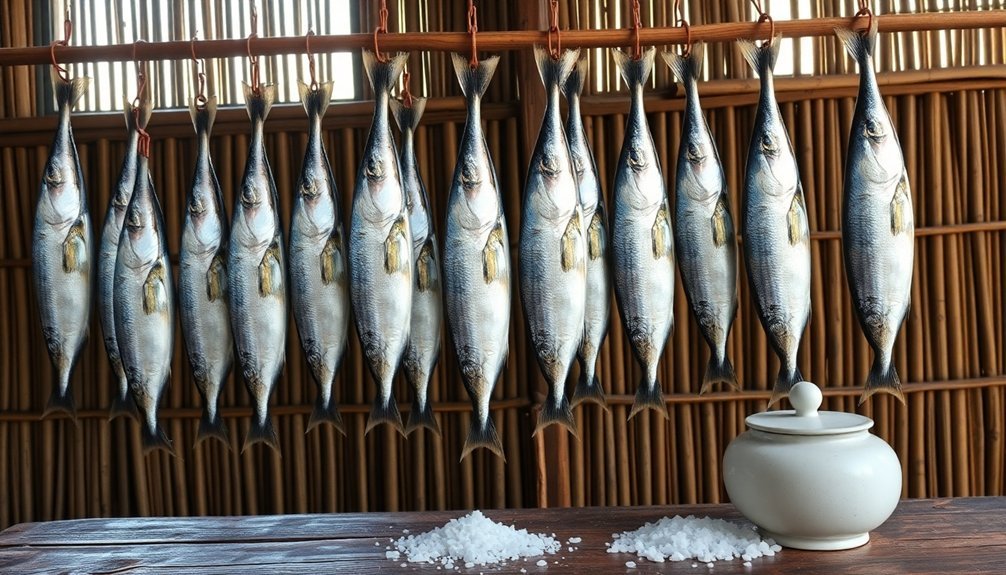
Successful storage of air-dried fish depends on choosing the right containers and maintaining ideal conditions. You'll need airtight containers or vacuum-sealed bags to prevent moisture and air from entering, which can lead to spoilage. For the best results, clearly label your containers with the date and type of fish to track freshness effectively.
Where you store your dried fish is just as important as how you package it. Keep it in a cool, dry place away from direct sunlight and heat. While room temperature storage works for short periods, refrigeration extends freshness up to two weeks, and freezing can preserve your fish for up to a year.
To maximize your dried fish's shelf life, follow these essential steps:
- Vacuum seal or tightly wrap the fish in plastic wrap or aluminum foil before refrigerating or freezing.
- Use desiccants in storage containers to control moisture levels.
- Conduct regular inspections for signs of mold or mildew, discarding any spoiled fish immediately.
Remember to check your stored fish periodically and verify package closures remain intact. If you're using plastic bags, squeeze out as much air as possible before sealing to prevent bacterial growth.
Quality Control Measures
Quality control in air-dried fish production requires strict attention to multiple vital parameters.
You'll need to maintain ideal temperature control, typically around 63°C for dehydrators, while guaranteeing uniform air movement throughout the drying process. It's essential to monitor the water activity level, keeping it at or below 0.85 to prevent harmful bacterial growth from organisms like S. aureus and C. botulinum.
You'll want to implement regular microbiological testing, including aerobic plate counts, to verify that your product meets safety standards.
Don't skip proper sanitation protocols – use elevated drying tables with polythene covers to protect against contamination, and make sure your staff follows strict hygiene procedures during processing.
You should establish a monitoring system that tracks vital factors like drying time, temperature, and humidity levels. Document these parameters consistently and conduct regular sensory quality assessments.
Ensure your fish pieces are cut to uniform thickness for even drying, and use appropriate packaging materials like HDPE bags to prevent moisture reabsorption.
Nutritional Benefits of Dried Fish
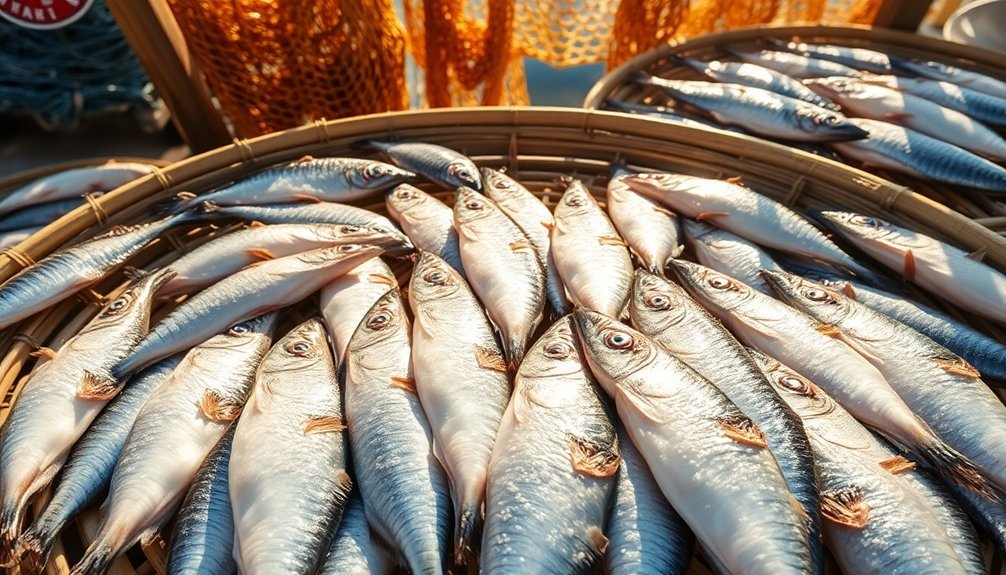
Beyond meeting safety standards, air-dried fish packs an impressive nutritional punch that makes it a standout protein choice. With just one cup providing 194 grams of protein, you'll get essential nutrients for muscle growth, tissue repair, and immune system support. This concentrated protein source also helps boost your metabolism and keeps you feeling fuller longer.
You'll benefit from the heart-healthy omega-3 fatty acids, particularly DHA, which reduce inflammation and support brain function. While being protein-rich, dried fish remains remarkably low in fat, containing only 5.9 grams per cup, making it an excellent choice for health-conscious consumers.
For ideal bone health and overall wellness, dried fish offers:
- A powerful combination of calcium and vitamin D, essential for preventing osteoporosis
- Important minerals like iodine and phosphorus that support thyroid function
- Essential vitamins, including niacin and vitamin A, that contribute to overall health
This nutrient-dense food doesn't contain carbohydrates or dietary fiber, making it an excellent protein source for various dietary preferences.
Whether you're building muscle, managing weight, or seeking heart-healthy options, dried fish delivers thorough nutritional benefits in a concentrated form.
Common Air Drying Mistakes
If you're air-drying fish without proper airflow control, you'll risk uneven drying and potential spoilage in areas where moisture remains trapped.
Your drying setup needs careful monitoring of temperature and humidity levels, as high humidity slows the drying process while excessive heat can cook rather than dry the fish.
Watch out for common mistakes like failing to protect your fish during wet weather or neglecting to adjust drying conditions based on the surrounding environment.
Poor Air Flow Control
Throughout the fish drying process, poor air flow control stands out as one of the most vital mistakes that can compromise quality. When you don't maintain proper air velocity of at least 3 m/s, you'll face notable challenges in moisture removal, especially when relative humidity is high.
The slow-moving air layers above your fish won't effectively transfer moisture, leading to inadequate drying and potential spoilage.
To avoid common air flow problems, you'll need to address these essential factors:
- Air Speed Management – You must guarantee consistent air velocity above 3 m/s to reduce the thickness of slow-moving middle layers and promote efficient moisture removal from your fish.
- Spacing Configuration – You'll need to prevent overcrowding by maintaining adequate space between fish pieces, allowing air to circulate evenly and prevent raw or undercooked areas.
- Humidity Control – You should maintain relative humidity between 45-55%, as levels above 60% will greatly reduce drying efficiency, even with high air speeds.
If you don't properly manage these elements, you'll risk developing hardened skin on your fish, which blocks further water removal and compromises the preservation process.
Temperature and Humidity Issues
Maintaining precise temperature and humidity levels poses significant challenges when air-drying fish. If you're not careful with temperature control, exceeding 60°C can trigger unwanted changes in your fish. While higher temperatures between 50-60°C might increase firmness, they'll also cause browning and lipid oxidation.
You'll get the best results by keeping temperatures between 25-30°C, with 27°C being ideal for most species.
Your humidity control is equally vital. You'll want to maintain relative humidity between 10-40% to prevent case hardening and guarantee effective drying. If you let humidity climb above 60%, you'll face slower drying times and risk spoilage at the center of your fish.
Conversely, if humidity drops too low, you'll encounter surface hardening issues that can ruin your product.
The interaction between temperature and humidity directly affects your drying success. When you don't manage these parameters correctly, you'll experience uneven drying, nutrient loss, and reduced shelf life.
In tropical conditions, you can use slightly higher temperatures up to 40°C, but you'll need to carefully control humidity between 35-60% to achieve peak results.
Best Packaging Materials
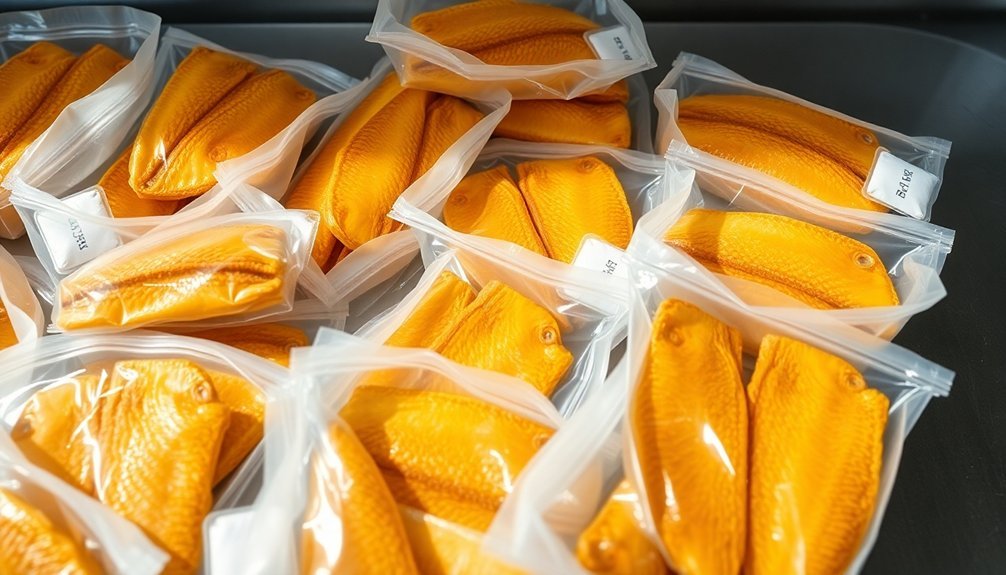
When selecting packaging materials for air-dried fish, you'll need options that excel in four key areas: moisture control, puncture resistance, contamination prevention, and consumer appeal. The right packaging will protect your product while maintaining its quality and attractiveness to consumers.
For ideal moisture control, choose materials with strong water vapor barriers like PVDC, coated OPP, or HDPE. You'll want packaging that maintains water activity below 0.85, which is essential for shelf stability. Multi-layered films and moisture-resistant laminates, such as polyester/polyethylene combinations, offer excellent protection against humidity.
Here are the most effective packaging solutions for air-dried fish:
- Five-layered co-extruded films combining LD-BA-Nylon-BA-Primocor for superior puncture resistance and mechanical strength
- Vacuum-sealed bags with food-grade plastic materials that create an oxygen-free environment
- PET and PP films with antifogging agents that maintain product visibility while preventing condensation
To enhance consumer appeal, opt for transparent packaging that lets customers see the product. Combined with proper labeling and design elements, these materials won't just preserve your air-dried fish – they'll also help it stand out on store shelves.
Extended Shelf Life Tips
Four essential factors determine how long your air-dried fish will stay fresh: proper drying technique, environmental control, storage conditions, and regular monitoring.
To maximize shelf life, start with the right drying method. Solar chimney or hybrid-solar drying systems will give you superior results compared to traditional open-air drying, with better quality and lower microbial contamination.
During the drying process, you'll need to maintain ideal temperature and humidity levels while ensuring proper air circulation.
Before drying, prepare your fish correctly. Clean it thoroughly, consider a brine treatment, and add salt or spices to enhance preservation.
You can also boil the fish in salt water to improve firmness before drying.
For storage, keep your dried fish in a cool, dry place and consider freezing for even longer preservation.
Don't forget to monitor moisture content regularly – it's vital for preventing spoilage. You should conduct monthly quality checks to catch any potential issues early.
Keep your storage area clean and protected from contamination sources.
Frequently Asked Questions
Can I Air-Dry Fish Indoors During Rainy Seasons?
You shouldn't air-dry fish indoors during rainy seasons as high humidity and poor ventilation can cause mold and spoilage. Instead, use a dehumidifier and fans, or consider investing in a fish-drying machine.
How Do Different Fish Species Compare in Terms of Drying Time?
You'll find croaker dries fastest, followed by sardine, while mackerel takes longest. The drying time varies by fish size – 50g samples dry quicker than 100g ones, regardless of species.
What Signs Indicate That Air-Dried Fish Has Gone Bad?
You'll know your air-dried fish has spoiled if you notice a sour or ammonia-like smell, see mold, find a slimy texture, or spot discoloration. Check for unusual softness and any visible signs of insects.
Is Air-Dried Fish Safe for Pregnant Women to Consume?
You can safely eat air-dried fish while pregnant if you choose low-mercury options and guarantee they're properly cooked. Stick to salmon, sardines, and trout, but avoid shark and swordfish. Always verify thorough cooking.
Can I Rehydrate Air-Dried Fish to Use in Fresh Recipes?
Yes, you can rehydrate air-dried fish for fresh recipes by soaking it in cold water for at least 4 hours. You'll get the best results using it in soups or stews where extra liquid helps restore texture.
In Summary
You've learned that successful air-dried fish preservation relies on proper moisture control, temperature management, and salt application. By avoiding common mistakes and using appropriate packaging materials, you'll extend your dried fish's shelf life considerably. Remember to focus on bacterial growth prevention and maintain ideal humidity levels throughout the process. When done correctly, you'll enjoy nutritious, well-preserved fish that stays fresh for months.

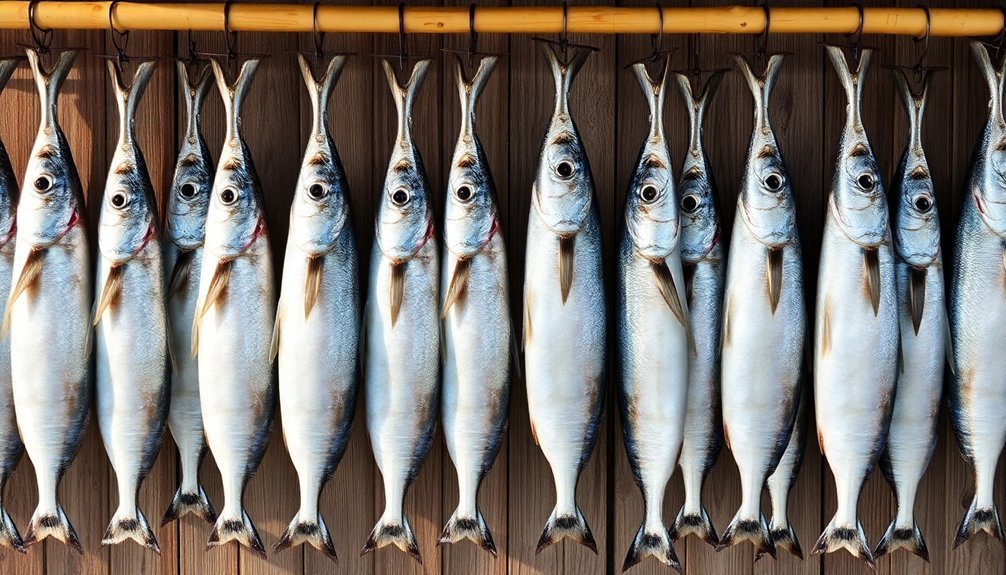



Leave a Reply